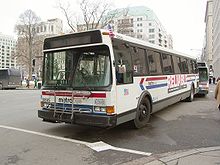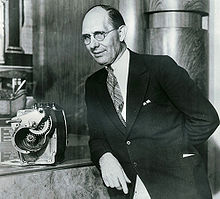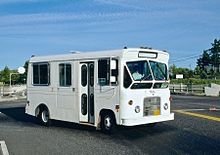Flxible
This article includes a list of generalreferences,butit lacks sufficient correspondinginline citations.(March 2020) |

The Flxible Co.(pronounced "flexible") was an American manufacturer of motorcyclesidecars,funeral cars,ambulances,intercity coachesandtransit buses,based in the U.S. state ofOhio.It was founded in 1913 and closed in 1996. The company's production transitioned from highway coaches and other products to transit buses over the period 1953–1970, and during the years that followed, Flxible was one of the largest transit-bus manufacturers in North America.[1]
History[edit]
In 1913, Hugo H. Young and Carl F. Dudte founded theFlexible Side Car CompanyinLoudonville, Ohio,to manufacture motorcycle sidecars with a flexible mounting to themotorcycle.The flexible mounting allowed the sidecar to lean on corners along with the motorcycle, and was based on a design patented by Young.
In 1919, the company dropped the first "E" in "flexible" and changed its name to TheFlxibleCompany as the business looked for new opportunities to expand.
After low-pricedautomobilesbecame available in the 1920s, the motorcycle sidecar demand dropped and in 1924, Flxible turned to production offuneral cars (hearses),andambulances,which were primarily manufactured onBuickchassis, but also occasionally onStudebaker,CadillacandREOchassis, andintercity buses,initially (1930s and early 1940s) built on GMC truck chassis, and powered with Buick Straight 8 engines.
Charles Kettering and General Motors[edit]

Charles Kettering,aLoudonville, Ohionative and vice president ofGeneral Motors,was closely associated with Flxible for almost the entire first half of the company's existence. In 1914, Flxible was incorporated with the help of Kettering, who then became president of the company and joined the board of directors. Kettering provided significant funding for the company in its early years, particularly after 1916, when he sold his firm, theDayton Engineering Laboratories Company (Delco),to GM for $2.5 million. Kettering continued to serve as president of Flxible, until he became chairman of the board in 1940, a position he held until his death in 1958.
After selling Delco to GM in 1916, Kettering organized and ran a research laboratory at GM and, by the 1950s, held the position of vice president at GM. As a result of Kettering's close relationship with both GM and Flxible, many GM parts were used in the production of Flxible vehicles, particularly prior to GM's 1943 purchase ofYellow Coach,a competing bus manufacturer, of which GM had been a majority owner since 1925. For example, most Flxibleambulances,hearsesand buses, from the mid-1920s to the early 1940s, were built onBuickchassis, and Flxible's "Airway" model buses of the mid-1930s were built on aChevroletchassis.

In 1958, as a result of theconsent decreefrom the 1956anti-trustcase,United States v. General Motors Corp.,[2]GM was mandated to sell their bus components, engines, and transmissions to other manufacturers, free of royalties. However, in the early 1950s and prior to the consent decree, Flxible built a small number of buses with GMdiesel engineswhile Kettering still served on the board. It has been postulated that GM may have made its diesel engines available to Flxible to reduce the criticisms of GM's business practices that some felt weremonopolistic.[3]The same has been said about GM's decision in the 1960s and 1970s not to produce a 35 ft (11 m) "New Look" transit bus with an 8-cylinder engine. However, it is also possible that GM chose not to enter that market because the potential sales did not warrant the added costs of engineering and production.[4]Another result of the consent decree, which was not settled in its entirety until 1965, was that GM was barred from having any of its officers or directors serve as an officer or director for any other bus manufacturing company. That provision would have applied to Kettering, had he not died in 1958.
Bus manufacturing[edit]

In 1953, Flxible absorbed thebus-manufacturing portion of theFageolTwin CoachCompany, and accepted its first order for transit buses from theChicago Transit Authority.In 1964, Flxible purchased Southern Coach Manufacturing Co. ofEvergreen, Alabama,and built smalltransit busesat the former Southern Coach factory until 1976. Flxible was purchased byRohr Industriesin 1970, and a newfactoryand corporate headquarters were built inDelaware, Ohio,in 1974, with the original factory in Loudonville, Ohio, being used to manufacture parts and sub-assemblies. Flxible was sold toGrumman Corporationin 1978 and became known asGrumman Flxible.The name reverted toFlxiblewhen Grumman sold the company in 1983 to General Automotive Corporation. In 1996, Flxible declaredbankruptcyand its assets were auctioned. The last Flxible vehicles were produced in 1995.
870 "A" frame problems[edit]
In the mid-1980s, severalGrumman 870buses operated by theNew York City Transit Authority(NYCTA) developed cracks in their A-shaped underframes. This prompted NYCTA PresidentDavid Gunnto remove the entire fleet from service. Soon, several other companies reported cracked 870 "A" frames. However, the frame issues primarily affected NYCTA 870s and not the 870s owned by the franchisees of theNew York City Department of Transportation,which were the first buses built with the problem rectified the following year. NYCTA attempted to get the remainder of its pending order for new buses transferred to GM, but was barred from doing so unless they could prove that the 870s were flawed and unsafe. The buses were eventually returned to Flxible, and were rebuilt and resold toQueen City MetroandNew Jersey Transit.Grumman blamed the problems with the NYCTA 870s on NYCTA's poor maintenance practices at the time, despite the fact that transit operations inChicago,Connecticut Transit,Houston,Los AngelesandOrange County, Californiahad also reported problems with their 870s. Regardless, NYCTA ordered fifty Metros in 1995, but Flxible closed its doors before the order was produced, and NYCTA obtained the remaining new buses fromOrioninstead.
Last transit buses in service[edit]
By the mid-2010s, very few transit systems were still operating any Flxible buses.Portland, Oregon'sTriMetretired its last Flxible buses in May 2015,[5]after which the only known continued use of Flxible buses in service was byCharleston Area Regional Transportation Authority(CARTA) inCharleston, South Carolina,and byMetro TransitinOmaha, Nebraska.[6]However, Omaha ordered replacement buses in summer 2018[7]and retired its last Flxible buses before the end of that year.[citation needed]Subsequently, CARTA retired its last Flxible buses in October 2019.[citation needed]
Engineering program[edit]
Flxible implemented a CAD program, CATIA, in the late 1990s to support production design. They were one of the first customers of IBM/Dassault.
Production outside the United States[edit]


Flxible's intercity buses were popular inMexicoand inLatin Americancountries. However, high import duties into these countries limited sales. In the early 1960s, Flxible began licensing a producer in Mexico,DINA S.A.(Diesel Nacional), to manufacture Flxible-designed intercity coaches, and this continued until the late 1980s. In 1965 and 1966, Flxible also licensed its "New Look" transit bus design toCanadair Ltd.,anaircraftmanufacturer inVille St-Laurent, Quebec.
In 1994, Flxible's parent company, General Automotive Corporation, and three other American companies –Roger Penske,Mark IV Industries, andCarrier– entered into a joint venture withChangzhou Changjiang Bus,aChinesemanufacturer located inChangzhou,Jiangsu province,to produce buses based on theFlxible Metrodesign and with the Flxible name. The resulting company, China Flxible Auto Corporation,[citation needed]manufactured buses in a variety of lengths, from 8 m (26 ft 3 in) to 11 m (36 ft 1 in). These buses, which include both front- and rear-enginedesigns, and share only their general exterior appearance with the American-built Flxibles, were sold to many transit operators in major Chinese cities, includingBeijingandShanghai.Atrolleybusversion was manufactured for only one operator, theHangzhoutrolleybus system, which bought 77 units between the late 1990s and 2001. For these vehicles, Changzhou Changjiang supplied the chassis and Metro-style bodies to the Hangzhou Changjiang Bus Company (in Hangzhou), and that company equipped them as trolleybuses.[8]
Products[edit]


- Motorcycle sidecar (1913-early 1920s)
- Intercity coach (1924–1932)
- Funeral car (1925–1942, 1946–1952, 1959–1964)
- Ambulance (1925–1952, 1946–1952, 1959–1964)
- "Airway" intercity coach (1932–1936)
- "Clipper" intercity coach (1937–1942, 1944–1950)
- Parts forLiberty ships,M4 tanks,F4U Corsairfighter aircraft, and Goodyear "L" typeblimps(1942–1945)
- "Airporter" intercity coach (1946–1950)
- "C-1" intercity coach (1950)
- "VisiCoach" intercity coach (1950–1958)
- FL "Fageoliner" transit bus (1953–1954)
- FT "Flxible Twin" transit bus (1953–1959)
- VL-100 "VistaLiner" two-level intercity coach (1954–1959)
- "StarLiner" intercity coach (1957–1967)
- "Hi-Level" intercity coach (1959–1962)
- "New Look" transit bus(1960–1978)
- "FlxLiner" intercity coach (1963–1969)
- "Flxette" light duty transit bus (1964–1976)
- "Flxible" Cruiser Motor Home (1967–1969)
- 870 "Advanced Design Bus"transit bus (1978–1982)
- METRO "Advanced Design Bus"(1983–1996); METRO "A" (1983–1987), METRO "B" (1988–1991), METRO "C" (1992), METRO "D" (1993–1994) and METRO "E" (1995–1996)
Buick conversions[edit]
-
1927 motorbus
-
1940 ambulance
-
1960 hearse
-
1963 hearse
Flxible Owners International[edit]


Flxible Owners International (see external link) was founded in the mid-1980s as an offshoot of theFamily Motor Coach Association,and is dedicated to the preservation of buses and coaches produced by Flxible. The organization holds a rally in Loudonville biannually, in even-numbered years and normally in mid-July, where many preserved Flxible coaches and buses may be seen.[9][10]
The majority of vehicles owned by members are of the Clipper series (Clipper, Visicoach, Starliner) that were produced from the 1930s until 1967. However, there are also quite a few "non-clipper" Flxible coaches that are owned, maintained, and operated by proud Flxible owners. This includes the Starliner, VL100 (VistaLiner), Hi Level, and Flxliner as well as some of the more modern transit buses. Most of these vehicles have been converted tomotor homes;however, there are still a few examples of seated coaches belonging to members.
See also[edit]
- RTS,a line of buses that competed with Flxible's last line of buses, the Flxible Metro
- New Flyer Industries,a bus manufacturer that has replaced Flxible in terms of dominance
References[edit]
This article includes a list of generalreferences,butit lacks sufficient correspondinginline citations.(March 2009) |
- ^Ebert, Robert R. (2001).Flxible: A History of the Bus and the Company.Yellow Springs, Ohio: Antique Power, Inc. pp. 134, 204, 222.ISBN0-9660751-2-9.
- ^United States v. General Motors(No. 15816E.D.Mich.1956).
- ^McKane, John H. & Squier, Gerald L. (2006), 17.
- ^McKane, John H. & Squier, Gerald L. (2006), 58.
- ^"Farewell to Portland's Last Flxibles".Bus Industry.Bus History Association. July 2015. p. 15.ISSN0739-7194.
- ^Morgan, Steve (September 2014). "The Flxible Metro – Catch Them While You Can".Bus Industry.Bus History Association. p. 21.
- ^Getting Road-Ready: How a Bus Earns its StripesAugust 16, 2018. Metro (Omaha).
- ^Trolleybus MagazineNo. 283 (January–February 2009), p. 15. National Trolleybus Association (UK).ISSN0266-7452
- ^Brewer, Jim (July 17, 2006)."1930 Flxible coach steals show at bus rally".Ashland Times-Gazette.Archived fromthe originalon March 2, 2012.RetrievedMay 28,2012.
- ^Brewer, Jim (July 21, 2008)."Flxible buses parade through downtown Loudonville".Ashland Times-Gazette.Archived fromthe originalon February 23, 2012.RetrievedMay 28,2012.
Further reading[edit]
- Crandall, Robert W.; Elzinga, Kenneth G. (2002-04-24)."Injunctive Relief in Sherman Act Monopolization Cases"(PDF).Journal of Research in Law and Economics.The Brookings Institution: 68–81. Archived fromthe original(PDF)on 2007-01-01.Retrieved2007-02-04.
- Georgano, G.N.,Editor (1978).The Complete Encyclopedia of Commercial Vehicles.Krause Publications.ISBN0-87341-024-6.
- Ebert, Robert R. (2001).Flxible: A History of the Bus and the Company,Yellow Springs, OH: Antique Power, Inc.ISBN0-9660751-2-9.
- Luke, William A. (2003).Flxible Intercity Buses: 1924–1970 Photo Archive,Hudson, WI: Iconografix.ISBN1-58388-108-5.
- Luke, William A. & Metler, Linda L. (2005).City Transit Buses of the 20th Century,Hudson, WI: Iconografix.ISBN1-58388-146-8.
- Luke, William A. & Metler, Linda L. (2004).Highway Buses of the 20th Century,Hudson, WI: Iconografix.ISBN1-58388-121-2.
- McKane, John (2001).Flxible Transit Buses: 1953–1995 Photo Archive,Hudson, WI: Iconografix.ISBN1-58388-053-4.
- McKane, John H. & Squier, Gerald L. (2006).Welcome Aboard the GM New Look Bus,Hudson, WI: Iconografix.ISBN1-58388-167-0
McPherson, Thomas A. (1993) "Flxible Professional Vehicles: The Complete History" Toronto, Ontario, Specialty Vehicle Press, ISBN
- Plachno, Larry."Back to the Futurliners"(PDF).National Bus Trader(February, 2001). National Bus Trader, Inc.: 16. Archived fromthe original(PDF)on 2006-11-10.Retrieved2007-02-07.
- Stauss, Ed (1988).The Bus World Encyclopedia of Buses,Woodland Hills, CA: Stauss Publications.ISBN0-9619830-0-0.
- History and Analysis of the Flxible Company,bw.edu,retrieved on 2007-02-07.
- Ohio Museum of Transportation,omot.org,retrieved on 2007-02-04.
- Ohio Museum of Transportation – Flxible Transit Coach Production Lists,omot.org,archived on 2005-08-28 onarchive.org,retrieved on 2007-02-04.




